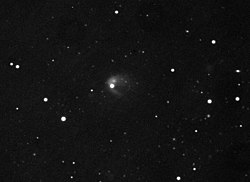596 Scheila
 596 Scheila outbursting as seen in a 5 min photo with a 24" telescope | |
| Discovery[1] | |
|---|---|
| Discovered by | August Kopff |
| Discovery site | Heidelberg Observatory |
| Discovery date | 21 February 1906 |
| Designations | |
MPC designation | (596) Scheila |
| Pronunciation | /ˈʃiːlə/ |
Named after | Sheila |
Minor planet category | main-belt[1] main-belt comet[2] |
| Orbital characteristics [1] | |
| Epoch 4 September 2017 (JD 2458000.5) | |
| Uncertainty parameter 0 | |
| Observation arc | 111.19 yr (40,611 days) |
| Aphelion | 3.4062 AU |
| Perihelion | 2.4490 AU |
Semi-major axis | 2.9276 AU |
| Eccentricity | 0.1635 |
Orbital period (sidereal) | 5.01 yr (1,830 days) |
| 21.266° | |
| 0° 11m 48.48s / day | |
| Inclination | 14.661° |
| 70.606° | |
| 175.16° | |
| Physical characteristics | |
Mean radius | 56.67±1.15 km (IRAS) |
Mean density | 2.0 g/cm3 (assumed)[3] 2.5 g/cm3 (assumed)[4] |
Equatorial escape velocity | 60 m/s (calculated)[3] 75 m/s (calculated)[4] |
Synodic rotation period | 15.8480 h (0.66033 d)[1] |
Geometric albedo | 0.0379±0.002[1] |
Spectral type | PCD (Tholen)[1] T (SMASSII)[1] |
Apparent magnitude | 11.67 to 15.32 |
Absolute magnitude (H) | 8.90[1] |
Scheila (minor planet designation: 596 Scheila) is a main-belt asteroid[1] and main-belt comet[2] orbiting the Sun. It was discovered on 21 February 1906 by August Kopff from Heidelberg.[1] Kopff named the asteroid after a female English student with whom he was acquainted.[5]
Overview[]
On 11 December 2010, Steve Larson of the Catalina Sky Survey detected a comet-like appearance to asteroid Scheila: it displayed a "coma" of about magnitude 13.5.[6] Inspection of archival Catalina Sky Survey observations showed the activity was triggered between 11 November 2010 and 3 December.[7] Imaging with the 2-meter Faulkes Telescope North revealed a linear tail in the anti-sunward direction and an orbital tail, indicative of larger slower particles.[8]
When first detected it was unknown what drove the ejecta plumes. Scheila's gravity is too large for electrostatics to launch dust.[2] Cometary outgassing could not be ruled out until detailed spectroscopic observations indicated the absence of gas in Scheila's plumes.[4] Observations by the Hubble Space Telescope and the Swift Gamma Ray Burst Mission's UV-optical telescope make it most likely that Scheila was impacted at ~5 km/s by a previously unknown asteroid ~35 meters in diameter.[3][4] In 2010, the Hubble Space Telescope observed the aftermath of a catastrophic collision that destroyed[dubious ] the much smaller asteroid P/2010 A2. Each asteroid the size of Scheila might be hit by an impactor 10–100 meters in diameter approximately every 1000 years, so with 200 asteroids of this size or bigger in the asteroid belt, we can observe a collision as often as every 5 years.[4]
Scheila last came to perihelion on 2012 May 19.[1]
See also[]
- 493 Griseldis (another possible asteroid collision, 2015)
References[]
- ^ a b c d e f g h i j k "JPL Small-Body Database Browser: 596 Scheila (1906 UA)" (2010-11-14 last obs). Retrieved 7 May 2016.
- ^ a b c David C. Jewitt. "Main Belt Comets". UCLA, Department of Earth and Space Sciences. Retrieved 15 December 2010.
- ^ a b c Jewitt, David; Weaver, H.; Mutcher, M.; Larson, S.; Agarwal, J. (2011). "Hubble Space Telescope Observations of Main Belt Comet (596) Scheila". Astrophysical Journal Letters. 733 (1): L4. arXiv:1103.5456. Bibcode:2011ApJ...733L...4J. doi:10.1088/2041-8205/733/1/l4.
- ^ a b c d e Bodewits, Dennis; Kelley, M. S.; Li, J. -Y.; Landsman, W. B.; Besse, S.; A'Hearn, M. F. (2011). "Collisional Excavation of Asteroid (596) Scheila". Astrophysical Journal Letters. 733 (1): L3. arXiv:1104.5227. Bibcode:2011ApJ...733L...3B. doi:10.1088/2041-8205/733/1/L3.
- ^ Schmadel, Lutz D. (2003). Dictionary of Minor Planet Names. Springer Science & Business Media. p. 61. ISBN 978-3-540-00238-3.
- ^ Ernesto Guido & Giovanni Sostero (12 December 2010). "Comet-like appearance of (596) Scheila". Remanzacco Observatory in Italy (blog). Archived from the original on 7 January 2011. Retrieved 12 December 2010.
- ^ Mike Simonsen (12 December 2010). "A Comet Masquerading as an Asteroid". Simostronomy (blog). Retrieved 12 December 2010.
- ^ Richard Miles's posting on Yahoo minor planet mailing list (MPML)
External links[]
- Comet-like appearance of (596) Scheila (Remanzacco Observatory)
- What's up with Scheila (596) (AARTScope Blog)
- Joseph Brimacombe animation on flickr
- (596) Scheila 2010-12-12 10:45:39UT (cbellh47 @ flickr)
- (596) Scheila by Rolando Ligustri (CAST-Italia)
- Comet-like appearance of (596) Scheila (MPML at Yahoo Groups)
- Asteroid 596 Scheila "Outburst" (Unmanned SpaceFlight)
- asteroid 596 Scheila goes cometary! (Cloudy Nights)
- UA Catalina Sky Survey Discovers Possible Extinct Comet (University of Arizona 2010 Dec 21)
- NASA's Swift and Hubble Probe Asteroid Collision Debris (04.28.11)
- Yang, Bin; Hsieh, Henry (2011). "Near-Infrared Observations of Comet-Like Asteroid (596) Scheila". The Astrophysical Journal. 737 (2): L39. arXiv:1107.3845. Bibcode:2011ApJ...737L..39Y. doi:10.1088/2041-8205/737/2/L39.
- Ishiguro, Masateru; Hanayama, Hidekazu; Hasegawa, Sunao; Sarugaku, Yuki; Watanabe, Jun-Ichi; Fujiwara, Hideaki; Terada, Hiroshi; Hsieh, Henry H.; Vaubaillon, Jeremie J.; Kawai, Nobuyuki; Yanagisawa, Kenshi; Kuroda, Daisuke; Miyaji, Takeshi; Fukushima, Hideo; Ohta, Kouji; Hamanowa, Hiromi; Kim, Junhan; Pyo, Jeonghyun; Nakamura, Akiko M. (2011). "Interpretation of (596) Scheila's Triple Dust Tails". The Astrophysical Journal. 741 (1): L24. arXiv:1110.1150. Bibcode:2011ApJ...741L..24I. doi:10.1088/2041-8205/741/1/L24.
- The cause of asteroid Scheila’s outburst (EPSC-DPS JOINT MEETING 2011 PRESS NOTICE)
- Lightcurve plot of 596 Scheila, Palmer Divide Observatory, B. D. Warner (2005)
- 596 Scheila at AstDyS-2, Asteroids—Dynamic Site
- 596 Scheila at the JPL Small-Body Database

- Minor planet object articles (numbered)
- Cometary object articles
- Background asteroids
- Active asteroids
- Discoveries by August Kopff
- Minor planets named for people
- Named minor planets
- Small-asteroids collision
- PCD-type asteroids (Tholen)
- T-type asteroids (SMASS)
- Astronomical objects discovered in 1906

